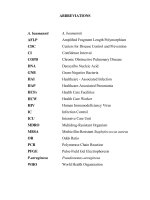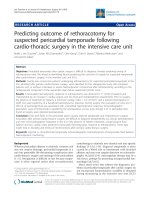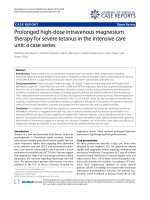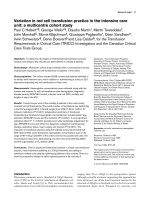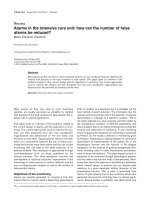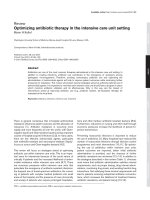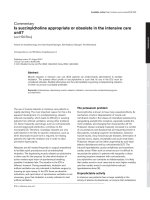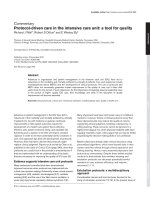Normal adrenocortical function on initial testing in the intensive care unit: not a long-term warranty pdf
Bạn đang xem bản rút gọn của tài liệu. Xem và tải ngay bản đầy đủ của tài liệu tại đây (41.17 KB, 2 trang )
Page 1 of 2
(page number not for citation purposes)
Available online />Abstract
There has been a lot of debate about the concept of relative
adrenocortical insufficiency (often defined as a reduced response
to corticotropin) as a pathophysiological explanation of steroid
effects in septic shock. Less is known about the prevalence of
absolute adrenocortical insufficiency based on more usual
definitions (low baseline and corticotropin stimulated cortisol). A
study by Wu and colleagues provides convincing evidence that
critically ill patients could evolve from a normal adrenal status
towards very low cortisol levels within a few days. Although the
exact consequences of these findings deserve more investigation,
adrenal testing should not be omitted in patients not improving
their hemodynamic status.
In the previous issue of Critical Care, Wu and colleagues [1]
report delayed adrenal insufficiency in 15 critically ill patients
on the basis of a repeated plasma cortisol test among a
prospective cohort of 53 patients who had normal or high
cortisol levels on first testing and did not exhibit clinical
improvement with treatment. Although 11 of these 15
patients received replacement doses of steroids, they had a
longer length of stay in hospital and longer duration of
mechanical ventilation. The authors must be congratulated for
these findings, which add a new piece in the complex puzzle
of adrenocortical function, steroid treatment and outcome in
the intensive care unit (ICU).
The renewal of interest for adrenal testing in critically ill
patients has been stimulated by the demonstration that
patients with septic shock treated with moderate doses of
hydrocortisone for seven to ten days displayed a more rapid
shock reversal than untreated patients and a probable
improved survival [2] and that septic patients not adequately
increasing their plasma cortisol concentrations in response to
a short corticotropin test had increased 28-day mortality
[3,4]. Taken together, these findings led some physicians to
suggest that these ‘supraphysiological’ doses of hydrocorti-
sone were an opotherapy addressed to a new pathophysio-
logical disorder: relative adrenal insufficiency (RAI). RAI
remains a controversial issue for several reasons. Although
most investigators would agree that its usual definition is an
absolute cortisol increase <9 μg/dl after a 250 μg
corticotropin IV bolus, irrespective of baseline cortisol value,
others use criteria related to ‘absolute’ adrenocortical
insufficiency where both baseline and stimulated cortisol
values are considered. In addition, the diagnostic perfor-
mance and reproducibility of the corticotropin test have been
challenged [5]. The best way to validate the RAI concept
would be to observe selective improvement in survival in
patients with RAI who were treated with hydrocortisone
replacement compared to untreated RAI patients. Although
the study by Annane and colleagues [6] supported this view,
the recent Corticus study [7] did not. The pathophysiological
significance of RAI remains unknown [8,9].
Conversely, ‘absolute’ adrenocortical insufficiency, usually
defined as a low basal cortisol concentration that cannot be
stimulated with corticotropin, seems to be uncommon in the
ICU population, at least in patients tested on admission,
except for those receiving etomidate to facilitate endotracheal
intubation. In the paper by Wu and colleagues, of the patients
who had initial cortisol levels that reasonably ruled out
adrenocortical insufficiency, 25% displayed low, and for 6 of
them, very low, cortisol levels within a mean time of 8 days.
Although, as the authors themselves acknowledged, neither
corticotropin testing nor measurement of free cortisol were
performed, these limitations would be more relevant to
patients with borderline cortisol levels (about 10 to 15 μg/dl)
than to patients with lower values [9]. One should also keep
in mind that albumin levels remained unchanged. In addition,
these patients required dosages of norepinephrine to be
Commentary
Normal adrenocortical function on initial testing in the intensive
care unit: not a long-term warranty
Pierre-Edouard Bollaert
Service de Réanimation Médicale, CHU de Nancy, Nancy, France
Corresponding author: Pierre-Edouard Bollaert,
Published: 2 July 2008 Critical Care 2008, 12:163 (doi:10.1186/cc6926)
This article is online at />© 2008 BioMed Central Ltd
See related research by Wu et al., />ICU = intensive care unit; RAI = relative adrenal insufficiency.
Page 2 of 2
(page number not for citation purposes)
Critical Care Vol 12 No 4 Bollaert
doubled, suggesting clinical symptoms possibly related to
absolute adrenocortical deficiency. Finally, the large decrease
in cortisol values in the patients whose clinical status did not
improve cannot be confounded with the usually observed
slow decrease towards moderately high cortisol values
observed for ICU patients [10].
Similar findings have been reported in septic patients who
were further tested after a mean time of six days because of
an inability to decrease vasopressor support and who
displayed low cortisol values with a similar range to those in
the study of Wu and colleagues. Resolution of vasopressor
dependence was achieved with steroid replacement [11]. In
a study on patients with liver disease, 16% of the patients
initially tested as having normal adrenocortical function later
developed absolute adrenocortical insufficiency according to
conservative criteria [12]. Importantly, the patients had
received no etomidate or ketoconazole in these two studies.
Finally, the timing of onset of adrenocortical insufficiency
suggests that what is often called ‘shock rebound’ just after
stopping a seven- to ten-day course of moderate doses of
steroids in septic shock patients could account for this
delayed adrenocortical insufficiency, thus needing further
testing [7,13].
As for RAI, the mechanisms of this ‘adrenal exhaustion’
syndrome are unclear. It has been found previously that low
levels of high-density lipoprotein are a good predictor of the
subsequent development of adrenal failure [12,14]; high-
density lipoprotein could be a rate-limiting substrate of
steroidogenesis in the adrenal cortex. However, this exciting
hypothesis has to be confirmed in appropriately designed
studies.
Could these results modify our current clinical practice?
While awaiting further studies, we should agree with the key-
message of Wu and colleagues: normal initial adrenocortical
function is not a warranty for the ICU stay and repeated
testing is needed according to the clinical evolution of the
patients. This message could also apply to patients recently
treated with steroids for septic shock.
Competing interests
The author declares that they have no competing interests.
References
1. Wu J-Y, Hsu S-C, Ku S-C, Ho C-C, Yu C-J, Yang P-C: Adrenal
insufficiency in prolonged critical illness. Crit Care 2008, 12:
R65.
2. Annane D, Bellissant E, Bollaert PE, Briegel J, Keh D, Kupfer Y:
Corticosteroids for severe sepsis and septic shock: a system-
atic review and meta-analysis. BMJ 2004, 329:480.
3. Annane D, Sébille V, Troché G, Raphaël JC, Gajdos P, Bellissant
E: A 3-level prognostic classification in septic shock based on
cortisol levels and cortisol response to corticotropin. JAMA
2000, 283:1038-1045.
4. de Jong MF, Beishuizen A, Spijkstra JJ, Groeneveld AB: Relative
adrenal insufficiency as a predictor of disease severity, mor-
tality, and beneficial effects of corticosteroid treatment in
septic shock. Crit Care Med 2007, 35:1896-1903.
5. Loisa P, Uusaro A, Ruokonen E: A single adrenocorticotropic
hormone stimulation test does not reveal adrenal insuffi-
ciency in septic shock. Anesth Analg 2005, 101:1792-1798.
6. Annane D, Sébille V, Charpentier C, Bollaert PE, François B,
Korach JM, Capellier G, Cohen Y, Azoulay E, Troché G, Chaumet-
Riffaut P, Bellissant E: Effect of treatment with low doses of
hydrocortisone and fludrocortisone on mortality in patients
with septic shock. JAMA 2002, 288:862-871.
7. Sprung CL, Annane D, Keh D, Moreno R, Singer M, Freivogel K,
Weiss YG, Benbenishty J, Kalenka A, Forst H, Laterre PF, Rein-
hart K, Cuthbertson BH, Payen D, Briegel J; CORTICUS Study
Group: Hydrocortisone therapy for patients with septic shock.
N Engl J Med 2008, 358:111-124.
8. Dickstein G: On the term “relative adrenal insufficiency” - or
what do we really measure with adrenal stimulation tests? J
Clin Endocrinol Metab 2005, 90:4973-4974.
9. Arafah BM: Hypothalamic pituitary adrenal function during
critical illness: limitations of current assessment methods. J
Clin Endocrinol Metab 2006, 91:3725-3745.
10. Vermes I, Beishuizen A, Hampsink RM, Haanen C: Dissociation
of plasma adrenocorticotropin and cortisol levels in critically
ill patients: possible role of endothelin and atrial natriuretic
hormone. J Clin Endocrinol Metab 1995, 80:1238-1242.
11. Guzman JA, Guzman CB: Adrenal exhaustion in septic patients
with vasopressor dependency. J Crit Care 2007, 22:319-323.
12. Marik PE: Adrenal-exhaustion syndrome in patients with liver
disease. Intensive Care Med 2006, 32:275-280.
13. Oppert M, Schindler R, Husung C, Offermann K, Gräf KJ,
Boenisch O, Barckow D, Frei U, Eckardt KU: Low-dose hydro-
cortisone improves shock reversal and reduces cytokine
levels in early hyperdynamic septic shock. Crit Care Med
2005, 33:2457-2464
14. van der Voort PH, Gerritsen RT, Bakker AJ, Boerma EC, Kuiper
MA, de Heide L: HDL-cholesterol level and cortisol response
to synacthen in critically ill patients. Intensive Care Med
2003,
29:2199-2203.
